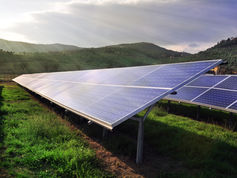Trump's Aversion to Green Tech Financing Risks Leaving America Last
- Fares Arafat

- May 5
- 4 min read
Three months into his presidency, Donald Trump's impact has been nothing short of disruptive. From century-old alliances being tested to a fundamental shift in global trade, few sectors have been spared, including the green tech industry. His recent tariffs on steel and aluminum have targeted the US's efforts to decarbonize its steel industry. This has resulted in analysts warning that the nascent U.S. green steel industry could be sidelined, missing out on critical decarbonizing opportunities. Moreover, experts warned that these tariffs could undermine global climate action by increasing the costs of renewable energy projects and straining international cooperation on climate initiatives.
Beyond tariffs, Trump has also targeted international development finance. Just weeks into his presidency, the administration enacted a 90-day pause on foreign aid, amidst a review of "all intergovernmental organizations" the U.S. is a part of. This would include organizations such as the World Bank and the Inter-American Development Bank (IDB), which have been vital financiers of clean energy projects throughout the Global South.
Apart from risking falling short of the $300 billion developing climate finance pledge made by developed countries at COP29, a figure deemed far below the recommended $1 trillion per year by researchers, Trump also risks leaving the U.S. strategically behind. In the new energy age, the Global South holds the cards. In the case of critical minerals, key metals essential for manufacturing clean technology, these regions control roughly 50% of the global supply.
Since 2013, China has recognized the strategic importance of the Global South, advancing development through its Belt and Road Initiative (BRI). This massive infrastructure and investment program has funneled around $1 trillion into its partner countries. Through this initiative, China has firmly cemented itself as a powerhouse in both critical mineral processing and green tech manufacturing. Their sustained investments in the metals and mining have enabled China to refine 68% of the world’s nickel, 40% of copper, 59% of lithium, and 73% of cobalt.
Nowhere is this more evident than in the Democratic Republic of the Congo, where China has entrenched itself as a central development partner through the BRI. As a result, it has managed to control roughly 70% of Congo's cobalt-rich mining sector and become a key global refiner, despite holding relatively few mines domestically, as illustrated in the figure below. When examining the US's dependency on the mineral, the impacts are significant. The U.S. imports 69% of its cobalt consumption, a metal critical for electric vehicle batteries, of which approximately 60% comes from China.
Another critical gap is U.S. overseas clean energy investment. Despite a Biden incentive to "promote the ending of international financing of carbon-intensive fossil fuel-based energy,” clean energy investment abroad still lags. Between 2018 and 2022, the U.S. government deployed approximately $46 billion in development finance overseas, yet only 5.6% was directed into building clean energy supply chains.
China, on the other hand, has spent more than $30 billion via its BRI last year alone on technology and manufacturing, targeting EV battery production, solar PV, and hydrogen. This issue was explored in a conversation with Jeremy Martin, Vice President of Energy & Sustainability at the Institute of the Americas, who noted that despite the U.S. having 20 free-trade agreements and the IRA offering subsidies to its partner countries, actual foreign investment in clean energy supply chains remains limited.
Suppose funding were to stop, or even drastically decrease, given the current administration's aversion towards green tech manufacturing domestically. In that case, it's not hard to see why the United States would fall behind its adversaries, who have begun solidifying their position in green tech financing abroad. This lack of commitment has real consequences, as seen during the Chilean protests between 2019 and 2022. To help ease tensions, the government withheld payments to energy generators, including renewables, in an effort to keep consumer electricity bills low. The IDB, a long-standing development partner on the continent, stepped in, financing the delayed invoices to prevent defaults and maintain investor confidence in the country’s electricity sector. When remembering these are the same banks Trump is looking to pause funding for, the risk of the U.S. forfeiting critical geopolitical leverage becomes clear.
The U.S. still has significant catching up to do, considering that China already dominates practically all aspects of clean energy technology manufacturing. And if history teaches us anything, it's the risks of overreliance on foreign nations in critical areas of the energy supply chain. Despite having ample reserves to meet domestic demand, the U.S. still imports more crude oil than it exports, primarily due to decades of reliance on foreign suppliers and underinvestment in refineries capable of processing its crude.
While the moral push to finance the Global South based on the historical emissions emitted by the Global North may not incentivize green tech finance by the current administration, a geo-strategic one could. Ultimately, a push to pause all foreign development in pursuit of an “America First” policy is likely to place America last in the race to source clean energy.













What a pant load. So-called "green energy projects" aren't, and spending trillions on FRAUD (solutions which will never replace fossil fuels and cost a backload more) actually SLOWS the energy transition to REAL solutions by diverting scarce resources to failed tech tracks.
This is all part of weakening us from the inside for Putin.